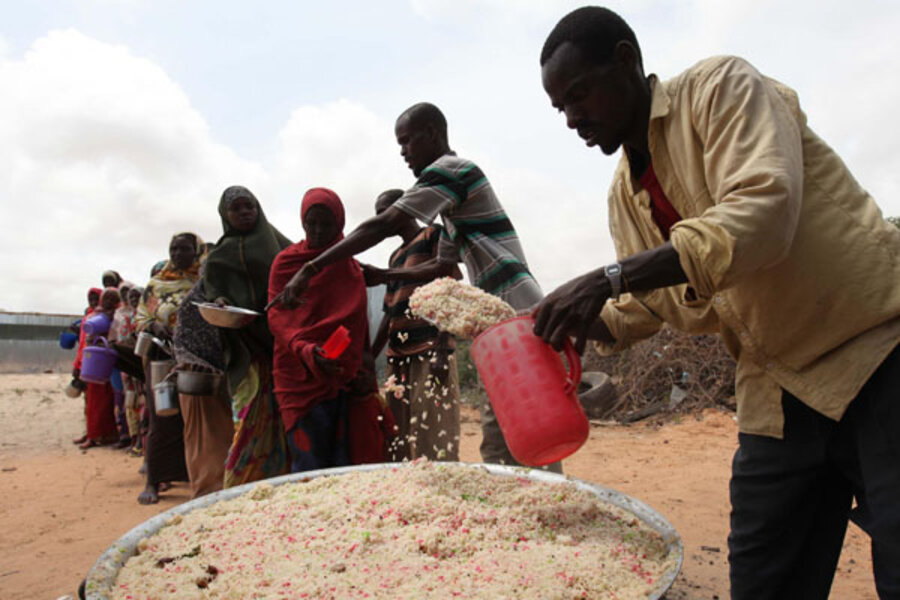Somalia famine has ended, but many still hungry
Loading...
| Nairobi, Kenya
This time last year a series of alarming reports from Somalia’s hinterland warned aid agencies that a “perfect storm” of factors was about to tip a long-running hunger crisis into Africa’s first famine in more than a decade.
Within months, 4 million people in one of the world’s most inaccessible countries needed urgent food handouts to keep them alive.
Today, thanks to better rains, reduced conflict, stable food prices, and international help, the situation is “much improved” and there is “little to no chance of a repeat of last year’s famine,” the United Nations reported.
“There are indications of improvement,” says Tamara Nanitashvili, chief technical advisor for the Food Security and Nutrition Analysis Unit (FSNAU) in Somalia, which is managed by the UN’s Food and Agriculture Organization.
“Pasture and water is available for livestock, the condition of the animals is very good, prices are favorable, and exports are up 42 percent compared to the same time last year," says Ms. Nanitashvili.
“We expect those exports to increase further in the upcoming season during Ramadan and Hajj.”
Still, 2.5 million Somalis, mostly in the country’s Islamist-held south, are officially classified as in “emergency” or “crisis.”
Almost a quarter of children aged under five are “acutely malnourished,” Nanitashvili added during a briefing in Nairobi, Kenya’s capital, where the international aid effort for Somalia is headquartered.
And there were warnings that rainfall in some farming areas in Somalia’s south would be up to 20 percent below average, which may cause localized food shortages.
“It could affect crop production, but it is still a much better picture than last year,” said Abdullahi Khalif, national technical manager for Somalia for the USAID-funded Famine Early Warning Systems Network.
In the lead-up to the declaration of famine in Somalia in July last year, a series of factors combined to create one of the country’s worst ever food shortages.
First, Al Shabab, the Al Qaeda-linked militia controlling much of the south, banned international aid agencies from its territory during 2010, saying that Western charities were “corrupting” the population.
Even in a good year, Somalia’s farmers cannot grow more than 40 percent of the food they need. The shortfall is largely made up for by international handouts. When these handouts dried up under the Al Shabab ban, nothing was left to fill the gap.
Soon after, the rains failed for two consecutive seasons, parching pastures, starving livestock, and withering crops in the fields. The cost of imported food, and the few stocks that traders had hoarded, shot up.
As the hunger began, hundreds of thousands of people gathered their belongings and tried to flee for help to neighboring countries. By the second half of 2011, international appeals for help topped $1.5 billion.
Now the picture looks significantly different. The good rains late last year and again early this year bodes well for the main harvest, due in July.
“Access for humanitarian agencies, mostly in Mogadishu, has also improved,” says Ms Nanitashvili.
But it would be wrong for the world to take its foot off the gas in terms of funding the international organizations – many of them from Islamic countries – that continue to operate in Somalia.
Al Shabab is, however, under pressure.
This week, it was pushed from Afgoye, a town northwest of Mogadishu where it is thought hundreds of thousands of people who fled famine have been squatting in makeshift camps. In theory, aid agencies can now reach them from the capital.
But on Tuesday, Islamist fighters ambushed President Sheikh Sharif’s convoy as it drove along the “newly liberated” road from Mogadishu to Afgoye. The President escaped unharmed but at least one of his military guards and two suspected Al Shabab fighters were killed.
Despite pressure from Kenyan, Ethiopian, and African Union armies, Al Shabab still controls the major towns of Kismayo and Merka, and holds sway over most rural areas in Somalia’s south.
Almost three-fourths of the 2.5 million people still needing help live in these areas.
“In farming communities, you will not see famine in the coming months, but you will see it returning very soon if all international assistance is removed for one year, as happened last year,” Ms Nanitashvili warns.







